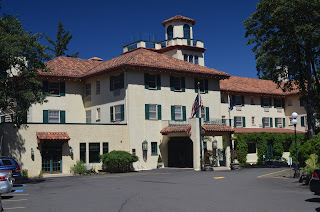The Huckleberry
Once we arrived in Coeur D’Alene, it didn’t take
long before we started seeing huckleberry products everywhere. During the spring and summer season, you can
find huckleberries practically on every street corner. They are sold dried, in
jams and even as a flavoring for ice cream. But what are they?
 |
| No, Not This! |
According to Linda Stradley, cookbook author and
culinary historian and author of “What’s Cooking America” (link below), huckleberries
are similar to blueberries and can be exchanged for them in recipes. She states
that huckleberries are tarter than blueberries and have a thicker skin as well
as seeds that make the berries crunchier. She also states that huckleberries
have been a staple food for thousands of years and that the Northwest tribes
used to dry the berries in the sun or smoke them and then would “mash them into
cakes and wrapped these in leaves or bark for storage.” (See
whatscookingamerica link below).
Dark berries with purple or bluish hues are rich in
polyphenols, and specifically anthocyanin. These are antioxidant nutrients that
are
 |
| This! |
protective against various cancers, heart disease, and they are also very
neuroprotective. Huckleberries are also the favorite food of a number of
different animals, including black and grizzly bears. So if you want to try a berry that is not as
commonly found as our blueberry but which has similar nutritional content as
well as a similar taste, come and get some huckleberries to try. Just be
careful if you decide to forage for them, as you might be invading a bear’s
favorite berry patch!
Sake Kasu
In the previous post, I mentioned that we found our
all time favorite traditional Japanese fish dish, “sake kasu” in the Bonsai
Bistro restaurant in Coeur D’Alene. Sake kasu is fish (black cod which is also
called sablefish) marinated in sake lees and then grilled or broiled.
What are Sake Lees?
Anyone reading this probably knows that “sake”, in
this case, refers to Japanese rice wine. The drink, sake, is served either cold
or warmed in special little cups. Romantically defined, sake lees are the
fermented dregs of the sake making process. They are the sediment that sinks to
the bottom of the barrel in either wine or beer making. The lees from making
sake can be used in making this fish dish or they can also be used to make
another traditional Japanese, but non-alcoholic fermented drink called
“Amazake”.
I first became acquainted with sake kasu when we
were living in Japan. We lived in a Japanese neighborhood and bought most of
our food from various food stalls that lined a particular street in our
neighborhood. Every day, I would take our daughter, Holly, then 3, out to get
our food for the evening meal. I loved stopping by the fish monger and looking
at all the different kinds and shapes of fish he had for sale. Most of the
time, I would ask the fishmonger how to prepare a fish that was new to me (most
were) and he would tell me how the particular fish was traditionally prepared.
One day, I noticed a vat of fish pieces marinating in a thick paste. I asked
him what that was and he said: “Sake kasu”. He explained that the paste was from
the process of making sake (rice wine) and that it was leftover from the
process. I also asked him how would I prepare this fish and how does it taste?
He told me that once home I should wipe the excess off the paste of the fish and
then grill or broil the fish. He also informed
me that it was delicious. I
asked him if we should eat the leftover paste and he said: “No”. So I brought
some home and we tried it for dinner. It was a huge hit and thereafter, became
one of our absolute favorite dishes. Years later, after returning to the U.S.,
I had forgotten about sake kasu, most likely because I have not seen it offered
in any of the Japanese restaurants around us in California, and I have not seen
the paste for sale in the oriental food store near us. So we had to come to
Coeur D’Alene, Idaho to be reunited with this delicacy!
 |
| Sake Kasu |
I
have since learned that sake kasu paste is not limited to the traditional
culinary use… Apparently it can also be used to make a cheesecake and even a
facial mask. (See links below). So now you can have your sake kasu AND eat it
too!
Links:









































